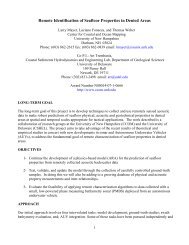Download PDF - AUVAC
Download PDF - AUVAC
Download PDF - AUVAC
Create successful ePaper yourself
Turn your PDF publications into a flip-book with our unique Google optimized e-Paper software.
UNMANNED EDUCATION<br />
THE<br />
Only Institution<br />
Dedicated to Unmanned<br />
Air, Ground & Sea Education<br />
(c) 2012 Unmanned Vehicle University<br />
© Unmanned Vehicle University<br />
917 Pacific Ave, Suite 206<br />
Tacoma, WA 98402<br />
admissions@uuxvuniversity.com<br />
Call > 206 – 787– 2807<br />
Fax > 206 – 299- 3587<br />
www.uxvuniversity.com
US Government will spend $6 Billion for Unmanned<br />
Vehicle Procurement in 2013. FAA approving UAVs to<br />
fly in civil airspace. Thousands of jobs available.<br />
UVU<br />
Send your new employees to our school<br />
to provide them with the most<br />
comprehensive Unmanned education in<br />
the world. Help them be more informed<br />
about your products and services so they<br />
can be better team players.<br />
SERVICES<br />
Providing the most<br />
comprehensive<br />
unmanned education<br />
in the world<br />
WHAT WE<br />
DO<br />
Education and training for unmanned<br />
vehicles used in air, ground, and sea<br />
applications<br />
UAV Executive Certificate Course<br />
Unmanned System Short Courses<br />
MS in Unmanned Systems Engineering<br />
PhD in Unmanned Systems Engineering<br />
Unmanned Air, Ground and Sea Vehicles<br />
All Courses Available On Site or Online<br />
Corporate Training<br />
Speaking Engagements<br />
Consulting<br />
Our place or yours Our courses Our Instructors<br />
Send your employees to our very<br />
modern facility at 917 Pacific Ave. We<br />
have a spacious conference room,<br />
refreshments and very accommodating<br />
staff. If you prefer, we can schedule a<br />
visit to your site with one of our<br />
instructors. If you are interested in<br />
some hands on flight training, we can<br />
schedule time at our flight facilities.<br />
We offer the most comprehensive<br />
Unmanned courses in the world. Our<br />
topics are very specialized and cover the<br />
latest advances. Unmanned vehicle<br />
technologies are progressing at a very<br />
rapid pace. At UVUI we continuously<br />
upgrade our courses to keep up. Real<br />
world examples are used to illustrate the<br />
underlying technologies.<br />
© Unmanned 2012 Unmanned Vehicle Vehicle University<br />
(c) 2012 Unmanned Vehicle<br />
University<br />
University<br />
Our subject matter experts are world<br />
class. They have an average of 25 years<br />
of experience in specialized Unmanned<br />
topics. Most are involved in research and<br />
development for new unmanned<br />
technologies. They have experience with<br />
both civil and government organizations<br />
that are developing and employing<br />
unmanned systems.
UAV Education & Training<br />
Unmanned Vehicle University Website<br />
MS & PhD Degrees<br />
Unmanned Sys Eng<br />
Executive Certificate<br />
All courses online<br />
Onsite<br />
3 Day Short Courses<br />
Corporate Training<br />
Taught Onsite<br />
Expert instructors<br />
www.uxvuniversity.com<br />
© Unmanned Vehicle University<br />
3
Faculty<br />
• Dr (Col Ret) Jerry LeMieux, PhD Electrical Engineering, MIT, Boston University<br />
• Dr Annie Shen, Ohio University Faculty, PhD Applied Mathematics<br />
• Dr (Col Ret) Richard Baker, Indiana State Univ Faculty, PhD Human Factors<br />
• Dr Robert Finkelstein, University of Maryland Faculty, PhD Cybernetics<br />
• Dr Pascual Marques, UK Aviation CEO, PhD Engineering Mechanics<br />
• Dr Dimitrius Gritzapis, Police Chief, Athens Greece, PhD Mechanical Eng<br />
• John Sauter, Director, Jacobs Technologies, UAV Autonomy Expert (25 yrs)<br />
• (Col Ret) Sanford Mangold, UAV Company CEO, MS Systems Management<br />
• Mark Jones, USAF Test Pilot, MS Engineering<br />
© Unmanned Vehicle University
• USA<br />
– Ohio<br />
– Pennsylvania<br />
– Washington DC<br />
– Washington<br />
• International<br />
– Greece<br />
– Peru<br />
– United Kingdom<br />
Campuses<br />
Expanding<br />
© Unmanned Vehicle University
Masters of Engineering Degree<br />
Unmanned Systems Engineering<br />
This specialized degree focuses on either unmanned air, ground<br />
or sea systems. Topics will include architecture, development,<br />
modeling & simulation, analysis, integration, test and<br />
management of complex systems and processes. Courses are<br />
taught online one night per week. Problems and exams are used<br />
to assess candidate progress. The program consists of 8 courses<br />
(32 credits) taken over 6 continuous quarters. One math and two<br />
systems engineering curses are required<br />
There is an option for a Master of Science Degree. For this<br />
program the student will take 6 courses and work with a Faculty<br />
member to publish an 8 credit Masters Thesis<br />
© Unmanned Vehicle University
PhD Degree<br />
Unmanned Systems Engineering<br />
• This specialized degree focuses on either unmanned air,<br />
ground or sea systems. Topics will include architecture,<br />
development, modeling & simulation, analysis, integration,<br />
test and management of complex systems and processes.<br />
Courses are taught one day per week. Problems and exams<br />
are used to assess candidate progress. The program consists<br />
of 10 courses (40 credits) taken over 10 continuous quarters<br />
and a PhD dissertation (24 credits). Two math and three<br />
systems engineering courses are required.<br />
© Unmanned Vehicle University
Graduate Courses<br />
Unmanned Systems<br />
• Introduction to Intelligent Vehicles<br />
• Introduction to Unmanned Aircraft Systems<br />
• Introduction to Unmanned Ground Systems<br />
• Introduction to Unmanned Sea Systems<br />
• Unmanned System Sensors and Characteristics<br />
• Unmanned System Communications and Data Links<br />
• Introduction to Unmanned Systems Operations<br />
• UAV Aerodynamics and Flight Stability<br />
• Unmanned System Autonomy<br />
• Unmanned Aircraft Vehicle Control<br />
• Unmanned Ground Vehicle Control<br />
• Unmanned System Navigation<br />
• Unmanned Aircraft System Flight Test and Evaluation<br />
• Unmanned Aircraft Propulsion<br />
• Unmanned Ground System Propulsion<br />
• Unmanned Sea System Propulsion<br />
• Unmanned System Alternative Power Design<br />
• Unmanned System Human Factors (Human Machine Interface)<br />
• Unmanned Ethics and Laws<br />
• Safety Management Systems<br />
© Unmanned Vehicle University
Graduate Courses<br />
Math & Systems Engineering<br />
• Probability<br />
• Statistics<br />
• Linear Algebra<br />
• Differential Equations<br />
• Numerical Analysis<br />
• Numerical Solution to Differential Equations<br />
• Encoding and Encryption<br />
• Introduction to Error Detection and Correction<br />
• Fundamentals of Modern Systems Engineering (Required)<br />
• Systems Engineering Management<br />
• Systems Requirements Analysis<br />
• System Design and Analysis<br />
• Radar Systems Engineering<br />
• Optical Systems Engineering<br />
• Communication Systems Engineering<br />
• Computer Systems Engineering<br />
• Modeling and Simulation for Systems Engineering<br />
• Scientific Principles of Test and Evaluation<br />
• Human Machine Interface<br />
• Reliability Engineering and System Safety<br />
• System Architecture and Design<br />
© Unmanned Vehicle University
Association for Unmanned Vehicle Systems<br />
International (AUVSI) Magazine<br />
April 2012 Edition<br />
© Unmanned Vehicle University
Association for Unmanned Vehicle Systems<br />
International (AUVSI) Magazine<br />
April 2012 Edition<br />
© Unmanned Vehicle University
Cascade Chapter<br />
Member of AUVSI<br />
© Unmanned Vehicle University
Cascade Chapter<br />
Member of AUVSI<br />
© Unmanned Vehicle University
Unmanned Vehicle University Booth #5040<br />
ENTER<br />
© Unmanned Vehicle University
Unmanned Systems<br />
3 Day Short Courses<br />
© 2012 Unmanned Vehicle University<br />
© Unmanned Vehicle University
Unmanned Aircraft Vehicle Design Course<br />
Mr Phillippe Roy, VP ATE AeroSurveillance<br />
Topics<br />
History, Mission & Applications, UAS System Description, Classes and Types, System Design Planning, Design Phases, Concepts,<br />
Reviews and Estimations, Airframe Design Configuration, Aerodynamics Configurations, Stealth Considerations, Payloads,<br />
Propulsion Systems, Control & Stability, Regulatory Aspects, Navigation Systems, Flight Control Systems, Navigation Sensors,<br />
Communications, LOS, BLOS, Control-Command, Data/BW, Launch & Retrieve Systems, GCS Architecture, GCS Implementations,<br />
Payloads, Sensors, Design for Reliability, Support Equipment, UAS Transportation, Certification Considerations<br />
Subject Matter Expert/Instructor Phillippe Roy is currently Vice President of ATE Aro-Surveillance and overseas business<br />
and product development activities for the company. He has over 25 years of worldwide experience in the defense and<br />
aerospace electronics industry with a specific emphasis in unmanned aircraft systems and technologies. He has direct experience<br />
in the development of Unmanned Aircraft Systems, avionics as well as a range of sensor processors, real time software<br />
computing and networking technologies. Prior to ATE for the past 13 years, Mr Roy has held several senior management<br />
positions at Mercury Computer Systems, who is one of the leading suppliers of sensor processor systems for the DoD. He has<br />
been involved in over 50 large programs including sensor payload suite for Global Hawk, Predator, JSTARS, Gorgon Stare as well<br />
as US and International programs such as Gripen fighter radar, F-18 and many others. He holds an electrical engineering from the<br />
University of Poiters, France, attended the Babson College MBA program, and graduated from the executive management<br />
program in Ivey School of Business in London Ontario. While at Mercury, Mr Roy received the 2007 Solution of the Year Award<br />
from Advanced Imaging Professionals for introducing the first mobile synthetic vision navigation system and making general<br />
aviation safer. Mr Roy is an active member of the ASTM F38 committee who has been appointed by the FAA to write the<br />
upcoming regulations for Small Unmanned Aircraft Systems. In 2010 he was granted primary inventor status and co author of<br />
patent 7,747,364 on methods , apparatus and systems for enhanced synthetic vision and multi sensor data fusion to improve<br />
operational capabilities of unmanned aircraft systems. He is a regular speaker at US and International conferences and<br />
referenced as an expert on unmanned aircraft systems and airborne payloads. He also holds a commercial pilots license for<br />
multi-engine aircraft with instrument privileges and is an active pilot with over 1800 hours including over 1000 hours of multiengine<br />
time.<br />
(c) 2012 Unmanned Vehicle University<br />
© Unmanned 2012 Unmanned Vehicle Vehicle University University
Unmanned Ground Vehicle Fundamentals Course<br />
Dr Robert Finkelstein, President, Robotic Technology Inc<br />
Topics<br />
UGV Basics, Intelligent Control Architectures, Deliberative & Reactive Control, Sensors & Perception, UGV Software Tools, UGV<br />
Communications, UGV Databases & World Modeling, UGV Mobility, UGV Effectors, UGV Propulsion, UGV Weapon Systems, UGV Interfaces &<br />
Displays, UGV Behavior & Environment, UGV Types & Effectors, Civil Robots, Automotive Robots, Industrial Robots, Agriculture Robots,<br />
Construction Robots, Mining Robots, Industrial Service Robots, Office & Facility Service Robots, Medical & Healthcare Robots, Military<br />
Robots, UGV Roadmaps, Emerging Robots for Civil Use, Biometric & Strange Robots, Humanoid & Legged Robots, Snake, Insect & Chimera<br />
Robots, Micro & Nanorobots, Robot Collectives & Swarms, Ubiquitous Intelligence, Robotics, Ethics & Law, Tactics, Strategy & Doctrine,<br />
Impact on Society<br />
Subject Matter Expert/Instructor Dr. Finkelstein has more than 40 years of experience in: intelligent systems and robotic vehicles;<br />
military and civil systems analysis; operations research; business development; technology assessment and forecasting. Dr. Finkelstein earned<br />
a Doctorate in the primary field of Systems Theory and Cybernetics and the supporting field of the Management of Science, Technology, and<br />
Innovation, the George Washington University (GWU, 1995); Ap.Sci. (Applied Scientist degree) in Operations Research (GWU, 1977); M.S. in<br />
Operations Research (GWU, 1974); M.S. in Physics (University of Massachusetts, 1966); B.A. in Physics (Temple University, 1964). Also:<br />
Diplomas from the U.S. Army Missile School (1967) and U.S. Army Ordnance School (1966); Certificates from the University of Tennessee<br />
Space Institute (Combat Obscuration Modeling, 1978) and University of California, Los Angeles (Battlefield Robotics, 1983), and postgraduate<br />
courses in Physics at MIT (1968-1970). As President of Robotic Technology Inc. (RTI) from 1985 to the present, Dr. Finkelstein is<br />
responsible for technical analyses, technology assessments and forecasts, operations research, business development, and other<br />
professional services, for government and industry - nationally and internationally - in military and civil advanced technology systems,<br />
especially robotics, unmanned vehicles, and intelligent systems. Dr. Finkelstein is the inventor (patent pending) of the Energetically<br />
Autonomous Tactical Robot (EATR), which was developed under sponsorship of the Defense Advanced Research Projects Agency (DARPA). He<br />
is Collegiate Professor for the University of Maryland University College, Graduate School of Management and Technology, and he received<br />
the 2010 UMUC Teaching Recognition Award. He is also Co-Director of the Intelligent Systems Laboratory in the Center for Technology and<br />
Systems Management in the University Of Maryland Clark School Of Engineering. Previously he served as a U.S. Army Ordnance Officer in<br />
Missile Intelligence. Dr. Finkelstein has authored more than 200 technical reports and studies. He contributed articles to numerous<br />
publications and wrote a quarterly column and served on the Editorial Board for “Unmanned Systems” and Board of Directors for the<br />
Association for Unmanned Vehicle Systems International. His books include Unmanned Vehicle Systems: Military and Civil Robots for the 21st<br />
Century and Beyond, Pasha Publications (1994), Defense Year-Book 1992 (“Combat Robotics: From the Kaiser to the New World Order”),<br />
Brassey’s Publications, and “Military and Civil Robotics: Intelligent Machines in War and Peace,” IGI Global Publishers (to be published in<br />
2012).<br />
(c) 2012 Unmanned Vehicle University<br />
© Unmanned 2012 Unmanned Vehicle Vehicle University University
UAV Autonomy and Swarming Course<br />
Mr John Sauter, Jacobs Technologies<br />
Topics<br />
AFRL, UAS Roadmap, ALFUS, Autonomy Aspects, Autonomy and the OODA Loop, Autonomy and Cooperation (AFRL, Measuring Autonomy,<br />
Control Theory Basics, Feedback Control, Adaptive, Examples of UAS Automation, Aerodynamics and Control, Flight Control. Autopilots, Fault<br />
Recovery, Advanced Adaptive Control, Path Planning, Trajectory Planning, Obstacle/Collision Avoidance, Formation Control, Sensor<br />
Processing, Platform Health Monitoring, Fault Detection, Recovery, Planning Algorithms, Control/Planning Languages, Task Allocation<br />
Algorithms, Scheduling & Coordination Algorithms, Higher Level Sensor Processing Algorithms (GMTI, ATR, target tracking …), General<br />
Optimization Algorithms, Risk Assessment/Management, Manned-Unmanned Coordination, Multi-UAV Control, Formation Control<br />
Algorithms, Intelligence & Autonomy, UAV Swarming, Swarming vs. Multi-UAV Control, Top Down Planning, Bottom Up Emergence,<br />
Surveillance, Multiple Target Tracking, Border Protection, CBRNE Plume Monitoring, Fast Boats, Decoy Swarms, Loitering Munitions, Swarm v.<br />
Swarm, Swarming Algorithms and Swarming UAVs, Boids, Neural Network, Stigmergic, Bottom-Up, Top-Down, Hybrid, Learning and<br />
Adaptation, Design Patterns for Swarming, Defining the Behavioral Rules, Defining the Environment, Evolving and Tuning the Parameters,<br />
Configuring the Swarm, Communicating Intent, Ensuring Performance, Monitoring (what is it doing and why), Limits of Human Control,<br />
Testing Complex Adaptive Systems, Embedded Monitors, Simulation and Testing, Complexity & Emergence, Swarm Intelligence, Swarming<br />
Missions, Swarming Technologies, Example Swarm Design, Human Interaction, Trust & V&V<br />
Subject Matter Expert/Instructor Mr. Sauter is the director of Jacobs Technology’s research group working on novel methods for the<br />
analysis and control of complex adaptive agent-based systems. This group has established an international reputation for its pioneering work<br />
in stigmergic algorithms using fine-grained agent-based systems for unmanned systems. John has over 25 years’ experience in research and<br />
development using fine-grained agent-based methods for modeling and control of complex systems ranging from swarming air vehicle<br />
control to distributed information analytics for massive data. He has led Jacob’s research in swarming unmanned vehicle control over the last<br />
thirteen years. John served as project manager and principal investigator on a number of defense studies and demonstrations of advanced<br />
unmanned systems. He managed the DARPA JFACC program to develop an adaptive air planning application in complex, dynamic threat<br />
environments. He led the OSD NII study to evaluate Jacob’s novel stigmergic swarming algorithms in several full scale simulation<br />
experiments run by the Space and Missile Defense Battle Lab. He led the team that successfully demonstrated the use of swarming<br />
algorithms controlling multiple ground and air vehicles in several tests held at Aberdeen Proving Grounds in 2004 and later at NASA’s Wallops<br />
Island in 2007 and 2009. He has also led projects in studying the effectiveness of swarming unmanned systems for several military<br />
applications including persistent surveillance, target tracking, fast boat surveillance, and perimeter protection. He is the author of over 25<br />
papers and holds three patents using agent-based technologies for the analysis and control of a wide range of systems<br />
(c) 2012 Unmanned Vehicle University<br />
© Unmanned 2012 Unmanned Vehicle Vehicle University University
Human Factors in Unmanned Systems Course<br />
Dr (Col Ret) Richard Baker<br />
Center for Unmanned Systems and Human Capital Development<br />
Indiana State University<br />
Topics<br />
Human Error, Human Tasking, Workload Management, Safety, Crew Performance, Human Physiology, Perception, Cognition,<br />
Communications, Situational Awareness, Remoteness, Human-Machine Interface, Human-Machine Behavior, Synthetic Vision, Reduced<br />
Sensory Information, Teamwork, Resource Limitations, Control Systems, Decision Making, Fatigue, Stress, Time Lag, Field of View, System<br />
Design Problems, Reliability/Standards, Unique Aerial/Land/Marine System Factors, Traffic Management, Qualification Training and<br />
Simulation.<br />
Subject Matter Expert/Instructor Doctor (Col Ret) Richard Baker is a member of the Indiana State University (ISU) Department of<br />
Aviation Technology, Executive Manager of the ISU Center for Unmanned Systems and Human Capital Development, and Director of the ISU<br />
Center for Homeland Security and Crisis Leadership. Dr. Baker holds a BS in Mathematics and MS in Computer Science from Indiana State<br />
University. He received his doctorate from Nova Southeastern University where he conducted a study in project management and leadership<br />
in Information Systems. Prior to entering the academic world, Dr. Baker had an extensive corporate career in Aviation and in Information<br />
Technology. He served as the Director of Human Factors and Safety for American Airlines where his responsibilities included crew resource<br />
management and safety training for all pilots and flight attendants. A past chairperson of the Air Transport Association’s Human Factors<br />
Committee, he also received professional certification in Risk Management from the Transportation Safety Institute. Additionally, he brings<br />
many years of executive level experience in Information Technology (IT) from corporations such as General Motors and Electronic Data<br />
Systems (EDS). As the Chief Consultant Systems Engineer, his responsibilities involved systems design, implementation, and disaster recovery<br />
planning for major corporations who relied on EDS for IT services. Dr. Baker is a proven military commander and aircrew member with<br />
extensive aviation, airspace, and base management experience. Retired as a Colonel from the Indiana Air National Guard in 2003, he held<br />
command positions including Indiana State Director of Operations, Indiana State Director of Support, 181 st Fighter Wing Support Group<br />
Commander, 181 st Mission Support Squadron Commander, and 181 st Chief of Supply. His total military experience includes twenty years in<br />
Operations; eleven years in Logistics; and five years in Support. During his tenure with the Air National Guard, he worked extensively with<br />
rapid response teams for counter-terrorism, the Counterdrug Operations at United States<br />
(c) 2012 Unmanned Vehicle University<br />
© Unmanned 2012 Unmanned Vehicle Vehicle University University
Unmanned Aircraft System Fundamentals Course<br />
Dr (Col Ret) Jerry LeMieux, Executive Director, Unmanned Vehicle University<br />
Topics<br />
Design Considerations, UAS Architecture, UAS Components, UAS Types, Civil Roles, Sensor Characteristics, Sensor Resolution, Target<br />
Acquisition, Atmospheric Absorption, Black Body Radiation, EO, IR, MSI, HSI, LIDAR, Gimbal Packages, Radar Basics, SAR, Weather & Space<br />
Effects, Com and Data Links, Lost Link, Multi UAS Control, UAS System Design, Launch & Recovery Methods, Propulsion, Navigation,<br />
Improving Reliability, Fault Tolerance, Redundancy, Fault Tolerant Control, FAA Regulations and DoD Operations, Federal UAS Regulation,<br />
Equivalent Level of Safety, Collision Avoidance & Sense and Avoid, Civil Airspace Integration, FAA Civil UAS Roadmap, Small UAS Rule, NASA<br />
UAS R&D Plan, RTCA SC 203, Sense and Avoid Systems, Human Machine Interface, Intelligent Control, Alternative Navigation Systems, Future<br />
UAS Capabilities, Case Study on Alternative Propulsion (Fuel Cells and Solar), Solar Panels, Solar Power Characteristics, Solar Panel Basic<br />
Principles, Solar Energy Theory, Efficiency & Power Balance, Solar Wing Design, Aerodynamics, Wing Loading, Past Designs, Fuel Cells,<br />
Performance, Types & Comparisons, Polymer Electrolyte Membrane Theory, Maximum Power Point Tracker & Controller, Horizon<br />
Regenerative Fuel Cells, Spatial Audio (3D Audio), Synthetic Vision, Brain Computer Interfaceม CRM, UAS Autonomous Operations<br />
Subject Matter Expert/Instructor Doctor (Col Ret) Jerry LeMeiux is an engineering PhD and pilot with over 40 years and 10,000 hours<br />
of aviation experience. With a BS on Electrical Engineering, Doctor LeMieux joined the USAF as a ROTC distinguished graduate. He is a Senior<br />
Pilot with over 2500 hours as a combat ready fighter pilot, instructor pilot and commander. While on active duty, Doctor LeMieux<br />
simultaneously completed the Masters and PhD degrees in Electrical Engineering. Doctor LeMieux has over 20 years of experience in<br />
program management, systems engineering and test and evaluation for AEW, fighter and tactical data link acquisition programs. He has<br />
experience with research, development, technology transfer, integration and flight test and evaluation. He has consulted on numerous<br />
airspace issues for the US Federal Aviation Administration, Air Force, Army, Navy, NASA, DARPA and all major defense contractors. Doctor<br />
LeMieux is currently working with the FAA sponsored RTCA Special Committee 203 on legislative and airspace issues related to integrating<br />
unmanned air systems into US National Airspace. He is a National Expert on both ground based and airborne UAS Sense & Avoid (SAA)<br />
systems. He is a co-author of a technical paper with the FAA on worldwide spectrum requirements for all US unmanned aircraft (to be<br />
presented by the FAA and at the World Radiocommunication Conference in 2012). He has recently contributed to the first FAA Certificate of<br />
Authority for a US Army UAS using a ground based SAA solution. Doctor LeMieux has over 20 years of course development and teaching<br />
experience at major Universities and Aviation Schools including; Boston University, University of Maryland, Embry Riddle Aeronautical<br />
University and Daniel Webster College. He has taught aeronautical, mechanical and electrical engineering and advanced mathematics<br />
courses at the undergraduate and graduate levels. Doctor LeMieux holds the Airline Transport License and was an airline pilot for Delta Air<br />
Lines for over 20 years. He has over 10,000 hours of flying experience with both domestic and international operations. For over 10 years he<br />
was the Executive Safety Chairman for the Airline Pilots Association in Washington DC where he was responsible for resolving airline safety<br />
issues US National airports.<br />
(c) 2012 Unmanned Vehicle University<br />
© Unmanned 2012 Unmanned Vehicle Vehicle University University
DAY 1<br />
INTRODUCTION<br />
BASICS<br />
TYPES & CIVILIAN ROLES<br />
SENSORS & CHARACTERISTICS<br />
SOLAR & FUEL CELL POWER<br />
DAY 2<br />
COMMUNICATIONS AND DATA LINKS<br />
UAS CONCEPTUAL DESIGN<br />
HUMAN MACHINE INTERFACE<br />
SENSE AND AVOID SYSTEMS<br />
AIRSPACE ISSUES<br />
DAY 3<br />
CIVIL AIRSPACE INTEGRATION<br />
UAV NAVIGATION<br />
AUTONOMOUS CONTROL<br />
CASE STUDY: UAS SWARMING<br />
FUTURE UAS CAPABILITIES<br />
UAV Fundamentals<br />
3 Day Short Course<br />
© Unmanned Vehicle University<br />
Contact: Dr JERRY LEMIEUX Email: administrator@uxvuniversity.com Phone: 206-787-2807 Web: www.uxvuniversity.com
Existing Clients<br />
• Degree program students, around the world<br />
• International lectures scheduled<br />
• AeroVironment Inc: New Employee Orientation<br />
• Johns Hopkins University/Applied Physics Lab<br />
• US Air Force<br />
• Society of Experimental Test Engineers<br />
• Singapore Air Force, DSTA, DSTO<br />
© Unmanned Vehicle University
Scheduled Events<br />
• UAV Fundamentals Course (3 Day Short Course)<br />
– JHU/Applied Physics Lab March 22-25<br />
– Singapore Military April 20-22<br />
• UAV Executive Course (8 Weeks)<br />
– Online May 9<br />
• UMS Masters Degree Courses<br />
– Online July 2<br />
• UMS PhD Degree Courses<br />
– Online July 2<br />
• Society of Flight Test Engineers Conference<br />
– 4 Hour Seminar Oct 2<br />
© Unmanned Vehicle University
Products<br />
• MS & PhD Courses (12 weeks, online)<br />
• UAV Executive Course (8 weeks, online)<br />
• 3 Day Short Courses<br />
– Can do in house or at customer site<br />
• Orientation Training, New Employees<br />
• Corporate Customized Training<br />
© Unmanned Vehicle University



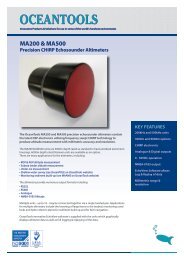

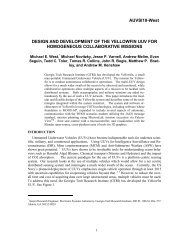

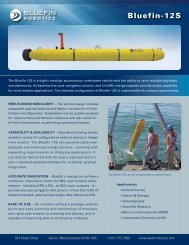
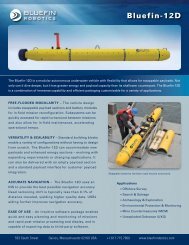


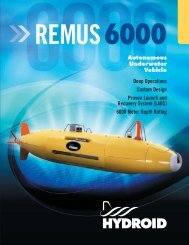


![Sonardyne Wideband Sub-Mini 6 [8270, 8271].pdf - AUVAC](https://img.yumpu.com/44408971/1/190x245/sonardyne-wideband-sub-mini-6-8270-8271pdf-auvac.jpg?quality=85)


